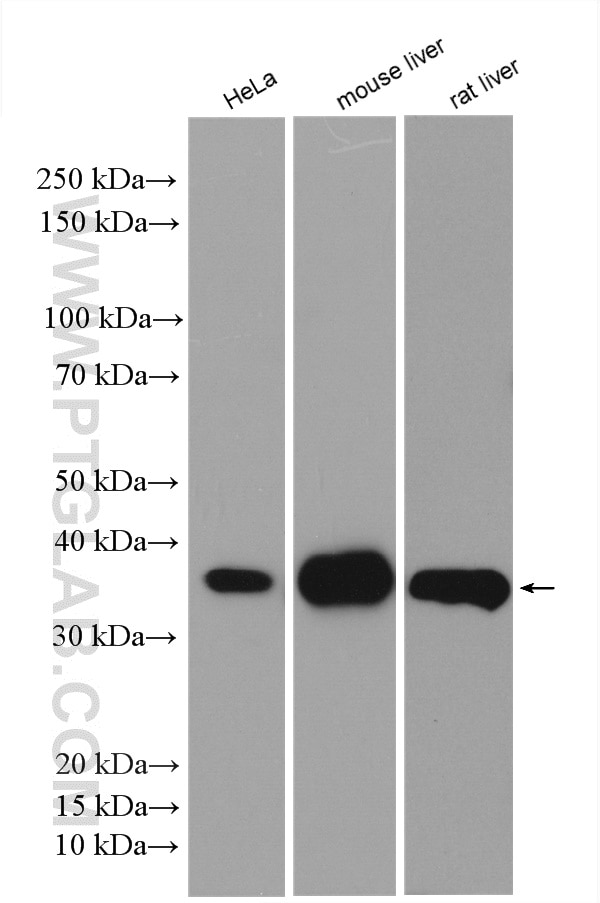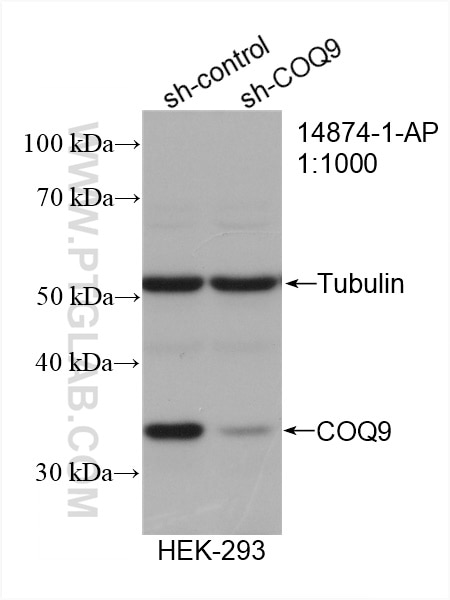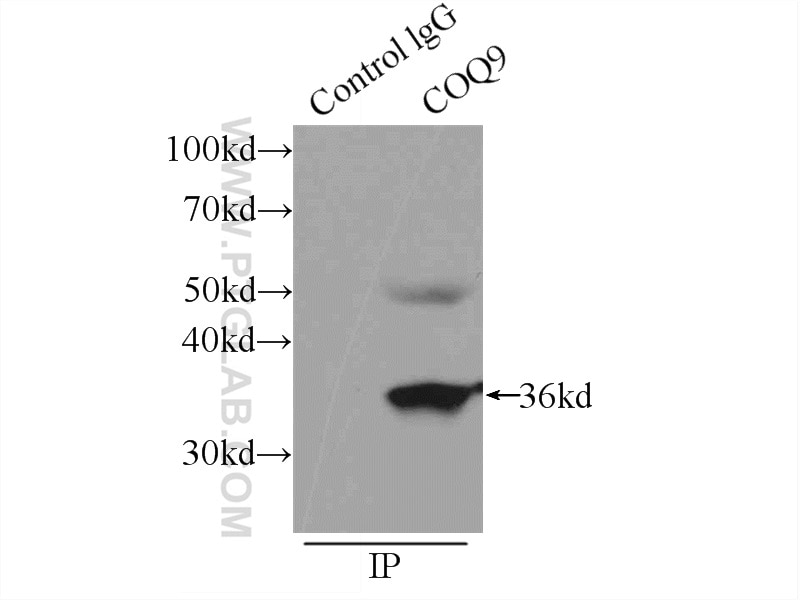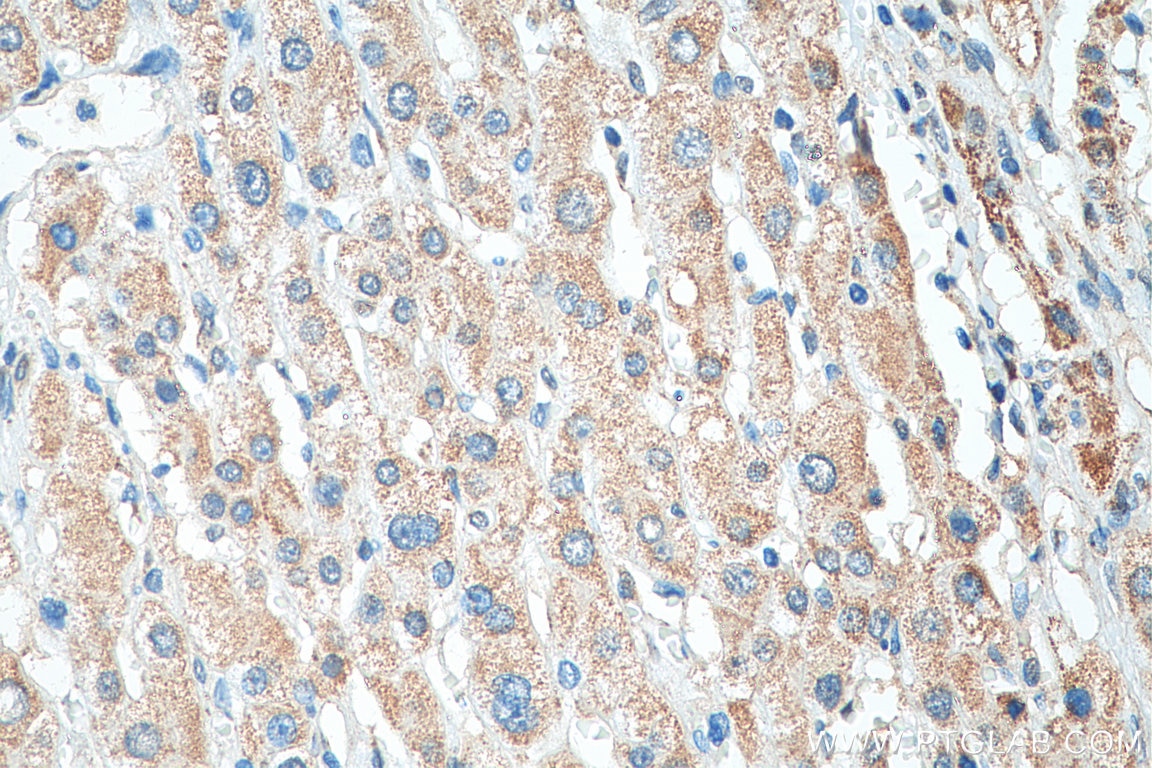- Phare
- Validé par KD/KO
Anticorps Polyclonal de lapin anti-COQ9
COQ9 Polyclonal Antibody for WB, IP, IF, IHC, ELISA
Hôte / Isotype
Lapin / IgG
Réactivité testée
Humain, rat, souris
Applications
WB, IHC, IF/ICC, IP, ELISA
Conjugaison
Non conjugué
N° de cat : 14874-1-AP
Synonymes
Galerie de données de validation
Applications testées
| Résultats positifs en WB | cellules HeLa, cellules HEK-293, tissu hépatique de rat, tissu hépatique de souris |
| Résultats positifs en IP | cellules HeLa |
| Résultats positifs en IHC | tissu de cancer du foie humain, il est suggéré de démasquer l'antigène avec un tampon de TE buffer pH 9.0; (*) À défaut, 'le démasquage de l'antigène peut être 'effectué avec un tampon citrate pH 6,0. |
| Résultats positifs en IF/ICC | cellules HepG2, |
Dilution recommandée
| Application | Dilution |
|---|---|
| Western Blot (WB) | WB : 1:500-1:2000 |
| Immunoprécipitation (IP) | IP : 0.5-4.0 ug for 1.0-3.0 mg of total protein lysate |
| Immunohistochimie (IHC) | IHC : 1:50-1:500 |
| Immunofluorescence (IF)/ICC | IF/ICC : 1:50-1:500 |
| It is recommended that this reagent should be titrated in each testing system to obtain optimal results. | |
| Sample-dependent, check data in validation data gallery | |
Applications publiées
| KD/KO | See 1 publications below |
| WB | See 5 publications below |
| IF | See 2 publications below |
Informations sur le produit
14874-1-AP cible COQ9 dans les applications de WB, IHC, IF/ICC, IP, ELISA et montre une réactivité avec des échantillons Humain, rat, souris
| Réactivité | Humain, rat, souris |
| Réactivité citée | rat, Humain |
| Hôte / Isotype | Lapin / IgG |
| Clonalité | Polyclonal |
| Type | Anticorps |
| Immunogène | COQ9 Protéine recombinante Ag6645 |
| Nom complet | coenzyme Q9 homolog (S. cerevisiae) |
| Masse moléculaire calculée | 36 kDa |
| Poids moléculaire observé | 36 kDa |
| Numéro d’acquisition GenBank | BC064946 |
| Symbole du gène | COQ9 |
| Identification du gène (NCBI) | 57017 |
| Conjugaison | Non conjugué |
| Forme | Liquide |
| Méthode de purification | Purification par affinité contre l'antigène |
| Tampon de stockage | PBS avec azoture de sodium à 0,02 % et glycérol à 50 % pH 7,3 |
| Conditions de stockage | Stocker à -20°C. Stable pendant un an après l'expédition. L'aliquotage n'est pas nécessaire pour le stockage à -20oC Les 20ul contiennent 0,1% de BSA. |
Informations générales
COQ9, also named as C16orf49, HSPC326, and PSEC0129, is a 318 amino acid protein, which belongs to the COQ9 family. COQ9 localizes in the Mitochondrion and is involved in the biosynthesis of coenzyme Q COQ9 has abilities to improve left ventricular performance and to reduce myocardial infarct size and cardiomyocyte apoptosis.
Protocole
| Product Specific Protocols | |
|---|---|
| WB protocol for COQ9 antibody 14874-1-AP | Download protocol |
| IHC protocol for COQ9 antibody 14874-1-AP | Download protocol |
| IF protocol for COQ9 antibody 14874-1-AP | Download protocol |
| IP protocol for COQ9 antibody 14874-1-AP | Download protocol |
| Standard Protocols | |
|---|---|
| Click here to view our Standard Protocols |
Publications
| Species | Application | Title |
|---|---|---|
J Clin Invest COQ6 mutations in human patients produce nephrotic syndrome with sensorineural deafness. | ||
J Am Soc Nephrol ADCK4 Deficiency Destabilizes the Coenzyme Q Complex, Which Is Rescued by 2,4-Dihydroxybenzoic Acid Treatment. | ||
J Med Genet Human COQ4 deficiency: delineating the clinical, metabolic and neuroimaging phenotypes. | ||
Front Physiol Human COQ9 Rescues a coq9 Yeast Mutant by Enhancing Coenzyme Q Biosynthesis from 4-Hydroxybenzoic Acid and Stabilizing the CoQ-Synthome. | ||
Mol Genet Metab Detection of 6-demethoxyubiquinone in CoQ10 deficiency disorders: Insights into enzyme interactions and identification of potential therapeutics.
| ||
J Cell Biol Coenzyme Q biosynthetic proteins assemble in a substrate-dependent manner into domains at ER-mitochondria contacts. |
Avis
The reviews below have been submitted by verified Proteintech customers who received an incentive forproviding their feedback.
FH Ying (Verified Customer) (03-31-2021) | This antibody works well for our westerns of cultured mouse cell extracts.
|







